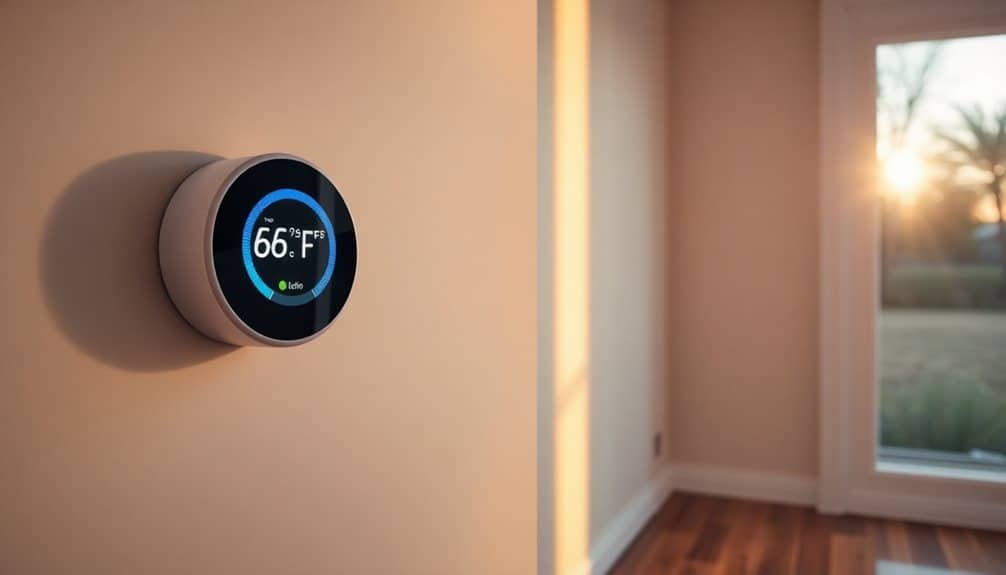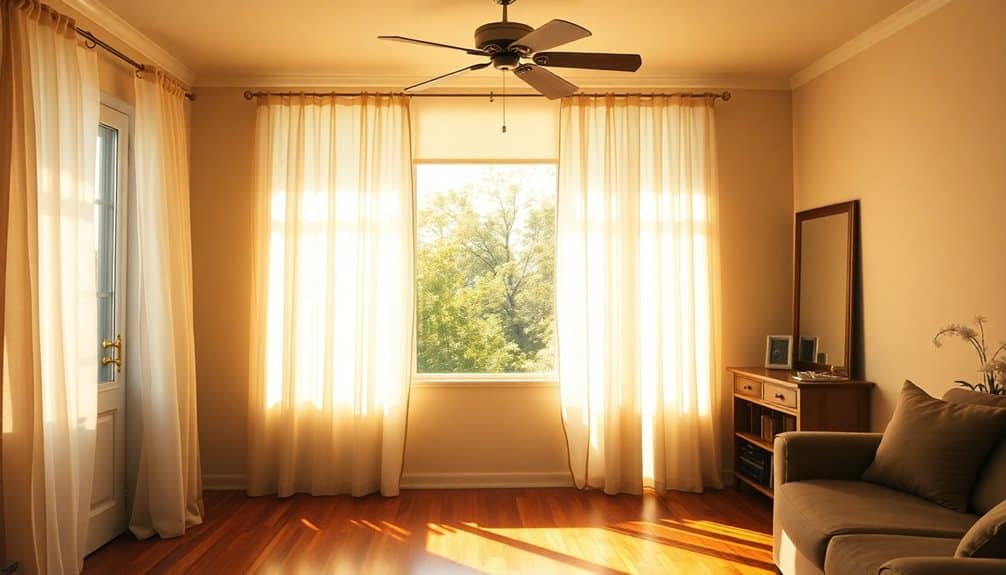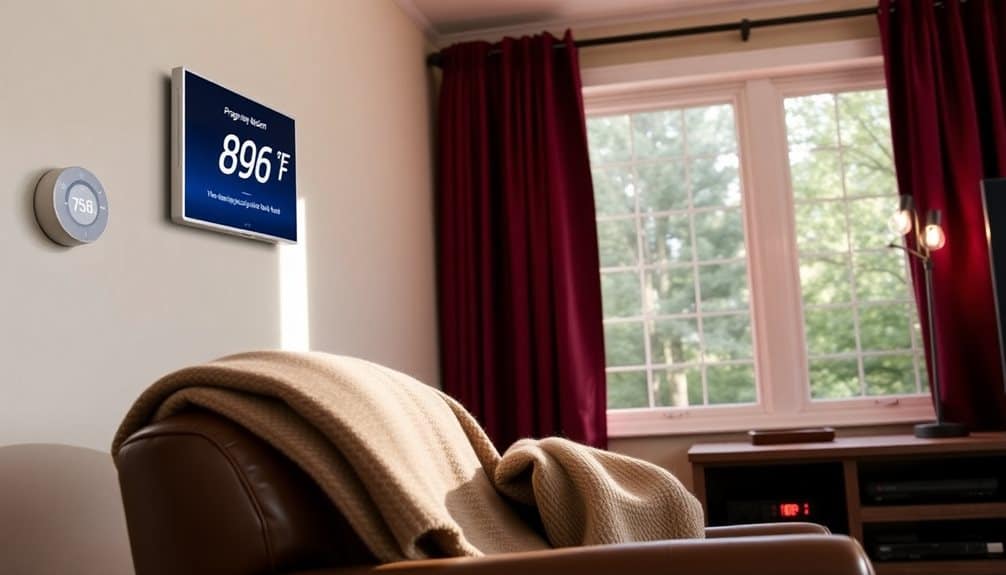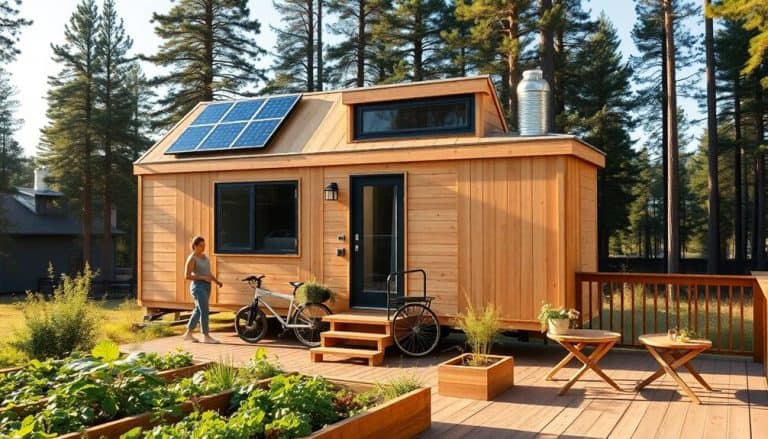This website contains affiliate links. Some products are gifted by the brand to test. As an Amazon Associate, I earn from qualifying purchases. The content on this website was created with the help of AI.
You’ll markedly reduce your monthly energy bills by implementing three proven, cost-effective methods. First, program your thermostat to automatically adjust temperatures based on your daily routines – each degree change saves about 2% on energy costs. Second, maximize natural light and ventilation by strategically opening curtains and creating cross-ventilation with windows on opposite sides. Third, optimize your appliances by washing full loads in cold water, skipping heat-dry cycles, and eliminating phantom energy drain with power strips. These simple changes can lead to savings of up to 15% annually, with even more opportunities to lower your utility costs.
Key Takeaways
- Adjust thermostat temperatures down 5-10 degrees when sleeping or away to save up to 15% on heating costs annually.
- Use cold water for laundry and skip the heat-dry cycle on dishwashers to reduce energy consumption significantly.
- Eliminate phantom energy drain by unplugging electronics or using power strips to cut unnecessary electricity usage.
- Open curtains for natural light during winter days and close them during summer peaks to reduce heating/cooling costs.
- Clean refrigerator coils twice yearly and maintain 37-40°F temperature setting for optimal energy efficiency.
Smart Thermostat Programming

Nearly every modern home has a programmable thermostat, but most aren’t optimized for maximum energy savings. You can slash your heating and cooling costs by up to 15% annually with proper thermostat programming. Start by setting temperatures based on your daily routine: lower the heat (or raise the AC) when you’re sleeping or away, and adjust it only when you’re active at home.
Program your thermostat to begin warming or cooling about 30 minutes before you wake up or return home. In winter, set the temperature to 68°F when you’re active and drop it to 62°F when you’re asleep or away. During summer, keep your home at 78°F while you’re present and let it rise to 82°F when you’re out. Each degree adjustment can save you roughly 2% on your energy bill.
Don’t forget to account for weekends differently than weekdays. Create separate programs for each day if your schedule varies. If you’ve got a smart thermostat, take advantage of its learning capabilities and remote access features to fine-tune your settings based on real-time usage patterns and weather conditions.
Natural Light and Ventilation

Throughout the day, you can harness natural light and airflow to reduce your reliance on artificial lighting and HVAC systems. Start by opening curtains and blinds during daylight hours, particularly on south-facing windows in winter months. Position your desk or reading areas near windows to maximize natural light exposure and reduce the need for electric lighting.
Create strategic cross-ventilation by opening windows on opposite sides of your home during cooler morning and evening hours. You’ll generate a natural breeze that can lower indoor temperatures by several degrees. Install window screens to keep insects out while maintaining airflow. During summer, close windows and blinds before the day heats up to trap the cool air inside.
Consider installing light tubes or solar tubes in darker areas of your home – they’re less expensive than skylights and can illuminate interior spaces effectively. Use reflective surfaces like light-colored paint and mirrors to bounce natural light deeper into rooms. White or pale window trim can also help diffuse sunlight throughout your space. During peak summer heat, use exterior shade solutions like awnings or deciduous trees to block intense sunlight while still allowing winter sun to warm your home.
Maintain optimal indoor humidity levels between 50-70% by strategically opening windows for ventilation, which helps filter pollutants and improve overall air quality.
Appliance Energy Optimization

With regular maintenance and smart usage habits, you can considerably reduce your appliances’ energy consumption. Start by cleaning your refrigerator’s coils every six months and setting its temperature between 37-40°F. Don’t overload it, and verify door seals are tight. When using your washing machine, wash full loads in cold water whenever possible and clean the lint filter regularly to maintain efficiency.
Your dishwasher will use less energy if you skip the heat-dry cycle and run it only when full. For your dryer, use the moisture sensor setting instead of timed drying, and clean the vent regularly to prevent restricted airflow. Consider air-drying clothes when weather permits.
Unplug electronics and small appliances when they’re not in use, or use a power strip to eliminate phantom energy drain. Replace old appliances with ENERGY STAR certified models when they need replacement. Check your appliances’ energy ratings and usage patterns through a simple energy meter – it’ll help you identify which ones are consuming the most power. Schedule regular maintenance checks for your HVAC system, and replace filters monthly to maintain peak performance. Similar to how annual inspections are crucial for beekeeping equipment, implementing yearly appliance maintenance ensures optimal efficiency and longevity.
Frequently Asked Questions
How Much Money Should I Budget for Basic Energy-Efficient Home Improvements?
You’ll need $200-500 for basic energy improvements that deliver quick payback. Start with $50-100 for weatherstripping, door sweeps, and outlet gaskets. Budget $100-200 for LED bulbs throughout your home. Add $50-100 for a programmable thermostat, and $100 for water-saving fixtures. Consider setting aside another $100-200 for basic insulation patches and duct sealing materials.
Can Renters Make Energy-Saving Modifications Without Violating Their Lease Agreement?
Like a wise guest who respects their temporary home while making it more comfortable, you can make energy-saving changes without upsetting your landlord. Start with removable window films, draft stoppers, and LED bulbs. You’ll save money with smart power strips, low-flow showerheads, and programmable thermostats – just keep the originals to reinstall when you move. Always get written permission for more permanent modifications.
Which Energy-Saving Habits Actually Increase Wear and Tear on Appliances?
While you’re trying to save energy, constantly turning appliances on and off can actually harm them. Frequent power cycling of your HVAC system, refrigerator, or washing machine stresses their motors and components. You’ll also damage your water heater by repeatedly switching temperatures. Instead, maintain moderate, consistent settings and use programmable timers. These practices save energy without accelerating appliance wear.
Do Solar-Powered Device Chargers Really Help Reduce Electricity Bills?
Every little bit helps, but don’t expect solar chargers to make a huge dent in your electricity bills. While they’re eco-friendly, most device charging costs only about $1-2 annually per device. You’ll need to use your solar charger consistently for 2-3 years to recover its $20-50 investment. Consider focusing on bigger energy draws like HVAC and appliances for more significant savings.
What’s the Most Cost-Effective Insulation Material for DIY Installation?
For DIY installation, fiberglass batts offer the best value, costing around $0.60-$1 per square foot. You’ll find them easy to handle and install between wall studs or in attic spaces. While cellulose and mineral wool are solid alternatives, fiberglass gives you the highest R-value per dollar spent. Just remember to wear protective gear during installation and guarantee proper fitting to avoid gaps that reduce efficiency.




